The post How to Improve Device Warranty Information Reporting appeared first on Recast Software.
]]>Device Warranty Information Reporting Overview
Device Warranty reports within Endpoint Insights empower organizations with rapid, powerful warranty data across OEMs, device types, and models. The data arrives in clear, actionable charts, which then quickly enables teams to plan accurately.
Device Warranty Information reports function by collecting computer warranty status details from every computer found within Microsoft Configuration Manager (ConfigMgr). It determines the computer’s manufacturer, model, and serial number. It then sends these details to our endpoint management software web service which in turn collects the warranty details from each manufacturer. The results (manufacturer name, model name, warranty details, etc.) are normalized and finally returned to the client. This process only requires a few seconds to complete!
In-Depth Insight with Device Warranty Information Reports
Device Warranty Information Reports offer a seamless integration with Microsoft Configuration Manager (ConfigMgr) and provides a comprehensive list of over 20 insightful reports. Companies can use these reports to streamline their budget planning, especially in multi-manufacturer environments with varying warranty terms.
The value of WIRs normalized, user-friendly charts cannot be overstated. The amount of extra work, on your part, of normalizing warranty results would theoretically be manageable if all computers had the exact same entries. But they don’t.
Thankfully, you can be assured that the Recast team works with each computer vendor to give you the cleanest and clearest results possible. It doesn’t matter if it is Dell, Lenovo, HP, or one of hundreds of other OEMS, Endpoint Insights automatically removes the unnecessary data and gives you the most precise warranty service level and end date information you need about each computer!
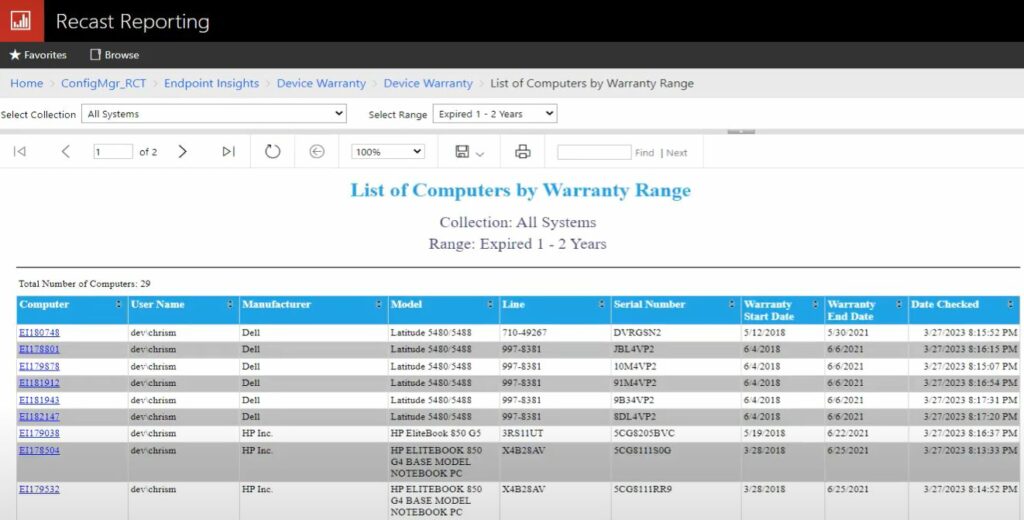
What You Need to Get Started with Device Warranty Information Reporting
Device Warranty Information Reports pulls the Make, BIOS date, Models, and Serial Numbers from your devices.
What If My Manufacturer Isn’t Supported? First, we support hundreds of OEMs, so this is atypical. However, if your devices are managed within Configuration Manager, there’s no need to fret if your manufacturer isn’t on our supported list. Endpoint Insights is designed to be proactive. When we encounter a new manufacturer through our API, we reach out directly to the vendor to gather the necessary details, ensuring your data is always up-to-date.
We also have a plan B for uber rare instances when warranty data isn’t available. The WIR within Endpoint Insights still has you covered. The system defaults to using the BIOS date to give you an approximate service term, so you’re never left in the dark.
Privacy Note: Your privacy is paramount to us. No identifying information like IP addresses, usernames, or computer names are ever sent to the Recast API.
The Future of Warranty Reporting
Our commitment to expanding our product capabilities has been relentless. The Device Warranty Information Reporting API is not only compatible with Microsoft Intune, but also features extended support for a broader range of mobile devices. Our development team is tirelessly working to keep expanding our list of supported mobile devices and related reports.
Additional Warranty Reporting Resources
- You Need Normalized Warranty Results
- Dell Warranty Status Woes
- How Old Are Our Computers?
- Get Your Hardware Refresh Budget Right
- Cost Effective Computer Replacement Plans
The post How to Improve Device Warranty Information Reporting appeared first on Recast Software.
]]>The post Get Your Hardware Refresh Budget Right appeared first on Recast Software.
]]>Warranty Information Reporting: A Game Changer
Many organizations struggle to accurately track all of their hardware’s warranty statuses. Many teams spend hours manually tracking devices in a spreadsheet, entering service tags one by one into multiple OEM’s (Original Equipment Manufacturer) websites to hunt down the warranty status. At best, some OEMs enable batch inputs of service tags. However, the batches are often constrained by number and OEM.
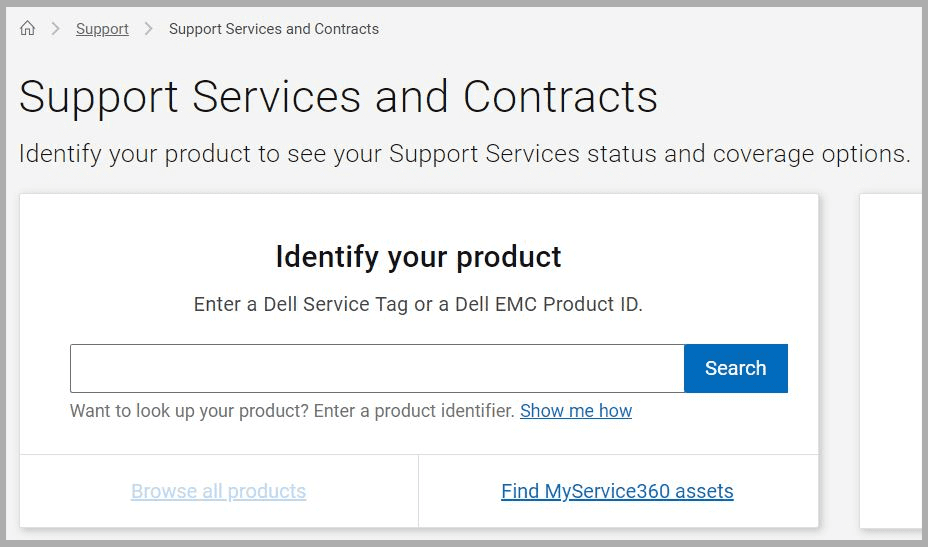
Endpoint Insights takes this challenge head-on with the Warranty Information Reporting feature. This innovative tool collects computer warranty status details from every device within your Microsoft Configuration Manager (ConfigMgr), including the computer’s manufacturer, model, and serial number. These details are sent to our endpoint management software web service, which collects the warranty details from each manufacturer. This process, while extensive, is lightning quick – only taking a few seconds per device.
The result? You get a normalized report featuring manufacturer name, model name, warranty details, and more on entire collections of devices. Additionally, this data only adds a few megabytes of data per device, so it is not bloating the database in the process. The warranty data capture workload changes from hours to a few automated seconds. Armed with this information, you can anticipate when computers are nearing the end of their warranty period, allowing for precise budget planning.
Computer Replacement Costs Calculator
Plan Your Hardware Refresh Budget with Confidence
Adding to the power of Warranty Information Reporting, Endpoint Insights offers a powerful Computer Replacement Costs Calculator. This feature displays projected computer replacement costs over the current year and upcoming years based on the total number of machines in your ConfigMgr’s hardware inventory and your custom replacement cost data.
With this tool, you can evaluate costs for computers based on their remaining warranty periods—be it expired or 1 to 3+ years left. This tool powerfully projects your device replacement budget, allowing you to prepare financially while minimizing the impact of unexpected costs.
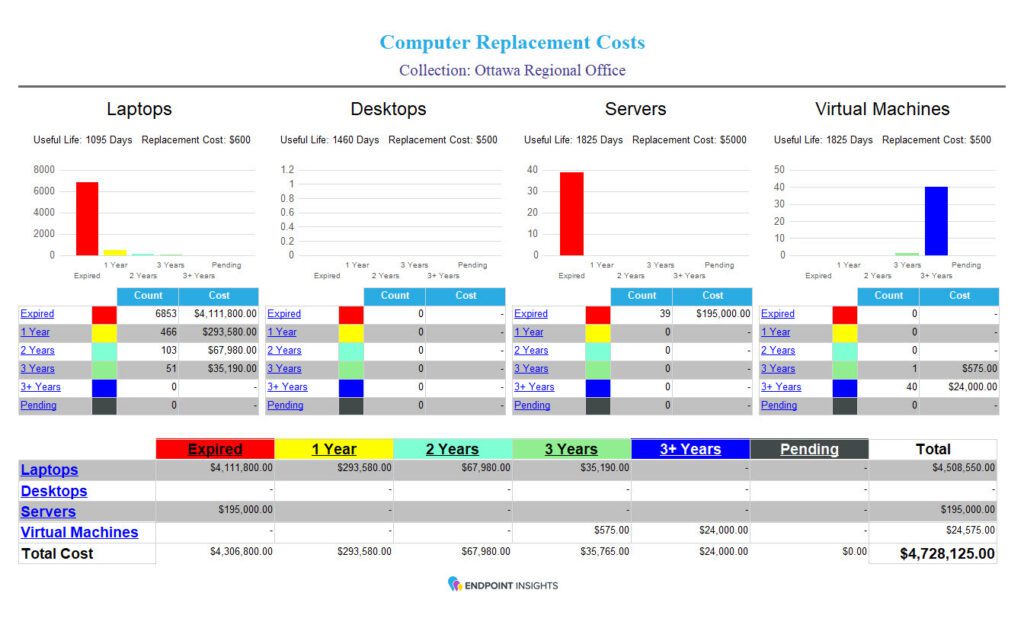
With most organizations operating on a three, four, or five-year refresh cycle for their computers, the ability to accurately list computers by age based on warranty status is profoundly helpful. Endpoint Insights provides this key information, enabling your organization to optimize the refresh cycle and allocate budget more efficiently.
Read here for a step-by-step guide into how to find the replacement cost on a specific collection of computers, as well as an explanation of how Endpoint Insights uncovers this data.
Get Your Hardware Refresh Budget Right
Harness the Power of Endpoint Insights
With Endpoint Insights, organizations can confidently predict their hardware refresh budget with accuracy. The combination of Warranty Information Reporting and the Computer Replacement Costs Calculator empowers organizations to reduce budget uncertainties and proactively make decisions.
Plan next year’s budget now and get ahead of the curve. Reach out to our team to learn more.
Learn more about Endpoint Insights:
- Read how customer Carr, Riggs & Ingram implemented Endpoint Insights and the Warranty Information Reporting tool to improve their efficiency
- Cost Effective Computer Replacement Plans
- How to Find the Replacement Cost for a Collection of Computers
- Endpoint Insights is Information
The post Get Your Hardware Refresh Budget Right appeared first on Recast Software.
]]>The post A Big Bank’s IT Asset Management Success Story appeared first on Recast Software.
]]>Wasted Service Calls and High Costs
With over 350,000 endpoints to support, this large national bank faced significant challenges in managing their IT infrastructure. Each service call to a workstation cost between $65-$100, and the bank knew they were wasting trips when replacing monitors due to a lack of information about the required hardware, including cables. This inefficiency was not only costing them time and money, but also affecting end-user productivity and satisfaction. IT techs often found themselves making multiple trips to the same location, as they would arrive onsite only to find that they did not have the correct equipment or information to complete the task. The bank needed a solution that would help them access and retrieve essential information, streamline service calls, and reduce overall costs.
Serious Savings by Powering up IT Asset Management
Endpoint Insights provided the bank with a clear way out of their IT management woes. By allowing them to instantly and remotely retrieve essential hardware data, the bank was able to cut down on the number of trips required for service calls. In the first year alone, the bank saved an estimated $1 million just on calls to replace monitors because the IT techs arrived with the correct cable type.
Additionally, the bank continues to expand its use of Endpoint Insights. As it moves toward a return to the workplace, Endpoint Insights is playing a significant role by assisting with the recovery of tens of thousands of monitors from employees’ homes.
The total savings Endpoint Insights has enabled is remarkable, even for this $100+ billion market cap company.
Key Features of Endpoint Insights
Endpoint Insights offers a range of powerful features designed to help IT professionals make better-informed decisions and optimize their IT asset management:
- Comprehensive View: See all computers, monitors, and docking stations in your environment, along with servers, printers, and users.
- Effective Software Management: Better manage software updates, deployments, and user-installed software for a more secure environment.
- Up-to-Date User Information: Access the latest information on users assigned to devices, ensuring efficient support and management.
- Warranty and Device Age: Quickly access device warranty status and device age for proactive budgeting and risk minimization.
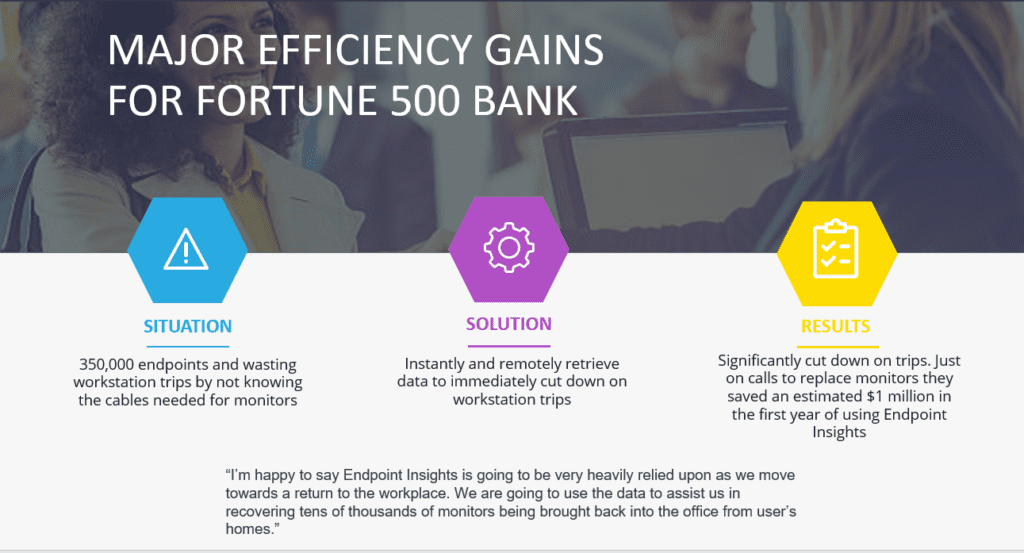
From Reactive to Proactive: The Endpoint Insights Asset Management Advantage
Endpoint Insights transforms IT asset management, moving companies from a reactive approach to a proactive one. Companies benefit from streamlined processes and serious efficiency gains. By providing clear insight into your IT environment and empowering your team with vital tools, Endpoint Insights can significantly reduce costs and improve the overall effectiveness of your IT department.
Learn more about Endpoint Insights, Recast Software, and our product suite.
The post A Big Bank’s IT Asset Management Success Story appeared first on Recast Software.
]]>The post No Need to Switch Endpoint Management Software appeared first on Recast Software.
]]>Right Click Tools and Endpoint Insights Enhance your Endpoint Management Software
Right Click Tools and Endpoint Insights are two powerful add-ons for Microsoft Configuration Manager that can supercharge your endpoint management capabilities. These tools are specifically designed by SysAdmins for SysAdmins to enhance ConfigMgr’s functionality, making it easier to manage and monitor your organization’s IT infrastructure. Importantly, both also work in co-managed environments.
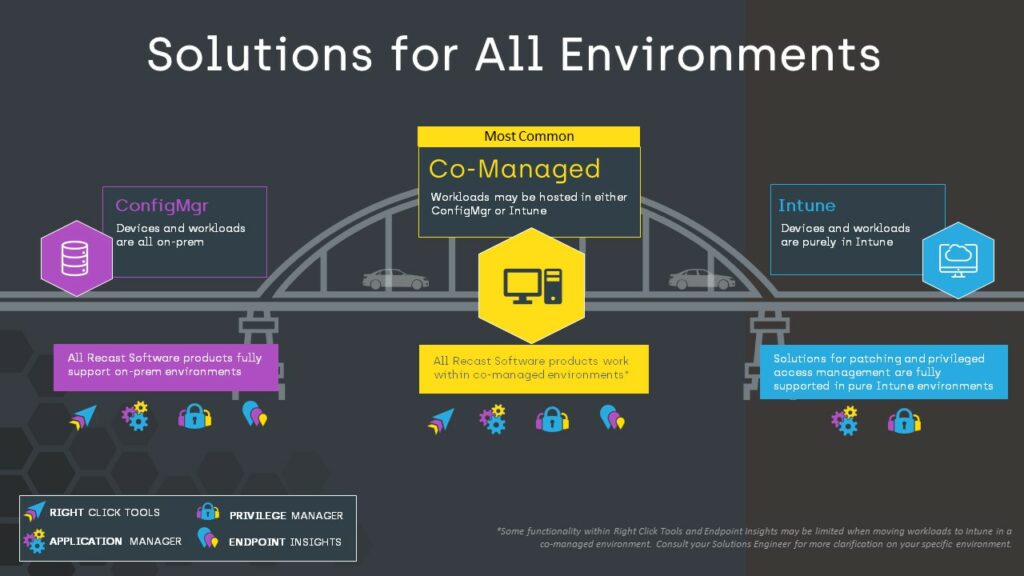
Right Click Tools: Power and Ease
Right Click Tools is a ConfigMgr extension that integrates seamlessly with ConfigMgr, adding a powerful layer of functionality and ease-of-use to your existing management console. With Right Click Tools, you can:
- Easily perform actions directly—both simple and advanced—from the ConfigMgr console, reducing the need for time-intensive digging in ConfigMgr or custom script writing.
- Streamline troubleshooting and maintenance tasks with built-in automation and scripting capabilities.
- Enhance security and compliance by quickly identifying and resolving potential issues, such as outdated software or misconfigured settings.

Endpoint Insights: Visibility and Health
Endpoint Insights is a comprehensive comprehensive data and reporting tool that provides deep visibility into your endpoint environment. By aggregating data from ConfigMgr and Active Directory, while also adding novel data from other sources, Endpoint Insights offers:
- A unified view of your endpoint environment, making it easy to identify trends, monitor performance, and ensure the health of your infrastructure.
- Clear reports that allow you to track the metrics that matter most to your organization.
- Proactive notifications to help you stay ahead of potential issues and maintain a healthy, secure endpoint environment.
Benefits of Staying with Microsoft Configuration Manager
By enhancing your existing ConfigMgr setup with Right Click Tools and Endpoint Insights, you can avoid the hassle and cost of switching vendors, while still enjoying a powerful, easy-to-use, and efficient endpoint management ecosystem. Some key benefits of staying with ConfigMgr include:
- Seamless integration: Right Click Tools and Endpoint Insights are specifically designed for ConfigMgr, ensuring a smooth and hassle-free experience. Their integration with the existing Microsoft ecosystem makes it much easier to manage your IT environment without introducing new complexities or learning curves.
- Familiarity: Your IT team is already familiar with ConfigMgr, so there’s no need for extensive retraining or learning a new system.
- Cost savings: Avoid the expenses associated with switching vendors, such as licensing fees, implementation costs, and potential downtime. By leveraging your existing Microsoft licenses and infrastructure, you can save on the costs of new software licenses, hardware requirements, and the additional training and support needed when adopting a new solution.
Conclusion: No Need to Switch Endpoint Management Software
You don’t have to switch vendors to enjoy a powerful and easy-to-use endpoint management ecosystem. By leveraging Right Click Tools and Endpoint Insights, you can enhance your existing Microsoft Configuration Manager or co-managed setup and enjoy a healthy, impactful endpoint management system without the hassle and expense of switching vendors. Learn more about Right Click Tools and Endpoint Insights or reach out to our team here.
The post No Need to Switch Endpoint Management Software appeared first on Recast Software.
]]>The post Customer Stories: Endpoint Insights Enables Powerful Device Warranty Management for Carr, Riggs & Ingram appeared first on Recast Software.
]]>Device Warranty Management at Carr, Riggs & Ingram
CRI has 2,100 endpoints in their environment, spread across the country both on-premises and in employees’ homes. IT Administrator Joseph Gipson of CRI explained how they utilize Endpoint Insights warranty data. “We pull in the licensing information and warranty information (using Endpoint Insights) every fall when we refresh our computers. Before Endpoint Insights, we used naming conventions to track how old computers were. Endpoint Insights helps a lot in that we can now see the exact warranty date on all our devices. It helps us make better decisions on what computers need replacing.” Before onboarding Endpoint Insights into their environment, new laptops were named using an internal convention to help understand the age of the device. This system worked moderately well, while also proving fallible and imprecise at times.
“Endpoint Insights helps a lot in that we can now see the exact warranty date on all our devices. It helps us make better decisions on what computers need replacing.”
Joseph Gipson, IT Administrator at Carr, Riggs & Ingram
“It’s way better (with Endpoint Insights),” Joseph continued. “Our IT department is really spread out across several states. We do a lot of virtual interaction. So, if somebody got the name or date wrong back when we used naming conventions, computers might be replaced when they had warranty left or replaced after their warranty expired.”
Device Warranty Management for Most OEMs
With dozens of Original Equipment Manufacturers (OEMs) supplying environments, many organizations spend significant time searching for their devices’ warranty information. Recast has unique insight into just how challenging and time consuming this research is for our customers, based upon both our conversations with hundreds of companies and our Google keyword search data. Of the search keywords that connect companies to our website, warranty status searches for HP and Dell, for instance, rise into the top handful of searches. To find warranty data natively, OEMs require individual searches by serial number, which adds up to significant amounts of time when companies have thousands or tens of thousands of endpoints to look up. Additionally, OEMs occasionally change their interface for accessing warranty data, requiring IT teams to readjust.
Endpoint Insights takes all this scattered warranty data from hundreds of OEMS and consolidates it into a single pane. With Endpoint Insights, you can quickly see warranty data on all your computers regardless of OEM, and then utilize the built-in calculator to accurately anticipate the replacement costs for this cycle and upcoming cycles as well. What used to take dozens of hours (even hundreds for larger organizations), now takes minutes from within your MECM / SCCM dashboards with Endpoint Insights activated and integrated.
Device Warranty Management Plus
We work with many organizations who add Endpoint Insights to their environments just for the consolidated warranty data alone. However, Endpoint Insights offers much more unique hardware and software data not natively available within MECM / SCCM. Hop on a call with one of our sales representatives to receive both a custom quote and a tour of the complete offerings of Endpoint Insights. Our customers’ stories verify that this upfront investment of your time will pay dividends in time saved over the months and years ahead.
The post Customer Stories: Endpoint Insights Enables Powerful Device Warranty Management for Carr, Riggs & Ingram appeared first on Recast Software.
]]>The post Endpoint Insights Webinar Series appeared first on Recast Software.
]]>September 27, 2022 – Endpoint Insights Hidden Gems
Take a look at some of Garth Jones’ favorite Endpoint Insights hidden features. Garth is the Architect of Endpoint Insights.
August 17, 2022 – Beyond the Reports
Watch as we take a look at how we can use the variety of different data that Endpoint Insights adds to the ConfigMgr database.
July 12, 2022 – Better Together
A look at how Endpoint Insights and Right Click Tools can be used together to keep your ConfigMgr environment running smoothly.
June 15, 2022 – Seamless Device Refreshes
May 17, 2022 – Inventory Management for Admins
Discover the hardware in your environment including User Installed Software, Warranty info, Monitors that are connected, and more!
The post Endpoint Insights Webinar Series appeared first on Recast Software.
]]>The post The Five Best ConfigMgr Reports appeared first on Recast Software.
]]>The 5 Best ConfigMgr Reports
1. Compliance 5 – Specific Computer
This one tops the list of best ConfigMgr reports because, for obvious performance and security reasons, it is really important to understand what software updates (SU) were applied or are going to be applied to a computer. This report shows you: what SUs were applied, which SUs are required, and which SUs need to be installed by a deadline.
Folder Location
It can be found within the Software Updates – A Compliance folder.
Microsoft Description
This report returns the software update compliance data for a specified computer.
Compliance 5 – Specific Computer Sample Screenshot
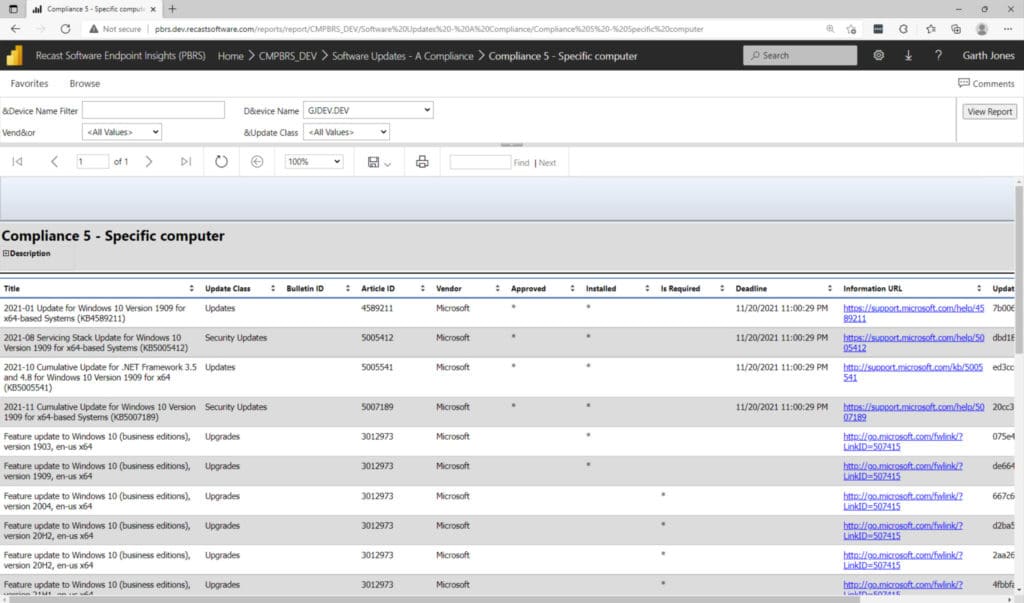
What’s Great about this Report?
- As was already pointed out, this is one of the best SCCM reports because it lets you know which SUs were applied to a computer, as well as what SUs need to be applied.
- If you have a list of missing Critical Updates, you can easily select them for a SU Group.
- Where appropriate, SU installation deadlines are noted.
- You can get more information about a particular SU by clicking on the handy URL.
2. Lifecycle 05A – Product Lifecycle Dashboard
This dashboard quickly shows you what Microsoft software products you need to replace NOW! You can also start proactively planning for product upgrades because the dashboard displays what needs to be replaced within the next 18 months.
In case you’re curious, the console report, along with this SSRS dashboard and its accompanying report set, was first released in the 1806 version of ConfigMgr current branch. Having the console report available as an SSRS dashboard enables you to create an email subscription to it, which you can’t do with the console version.
Folder Location
It can be found within the Asset Intelligence folder.
Microsoft Description
This report provides an overview of product lifecycle data in the hierarchy. The data is the same as what is displayed in the Product Lifecycle dashboard in the console.
Lifecycle 05A – Product Lifecycle Dashboard Sample Screenshot
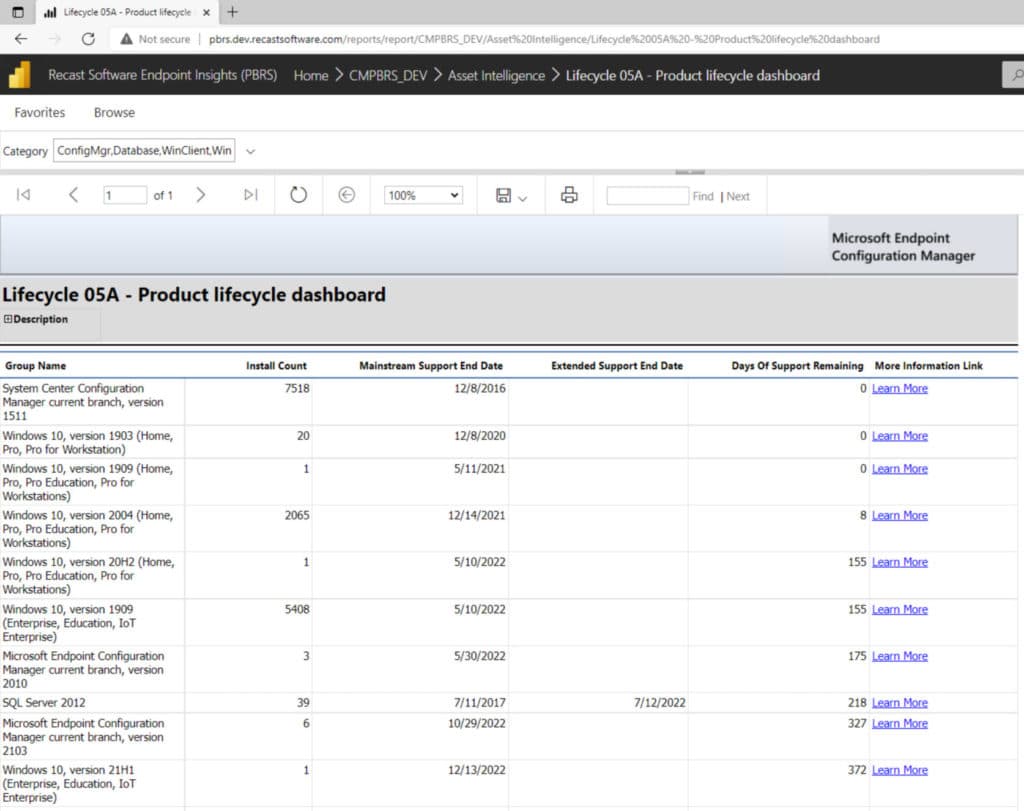
What’s Great about this Report?
- This SCCM software report comes out on top because, without having to go out and search the internet for the lifecycle dates for each product, you can see their status in one place!
- It allows you to proactively determine what software needs to be replaced and when!
- You can email this SSRS dashboard to your management team each month for them to review the status of your environment.
3. Count of all instances of software registered with Add or Remove Programs
This is the best and most reliable built-in ConfigMgr report for obtaining a good overall understanding about what software is installed within your ConfigMgr environment. Keep in mind, however, that software titles are not normalized in this report.
Folder Location
It can be found within the Software – Companies and Product folder.
Microsoft Description
Displays a summary of all instances of software installed and registered with Add or Remove Programs or Programs and Features on computers within the specified collection.
Report #3 Sample Screenshot
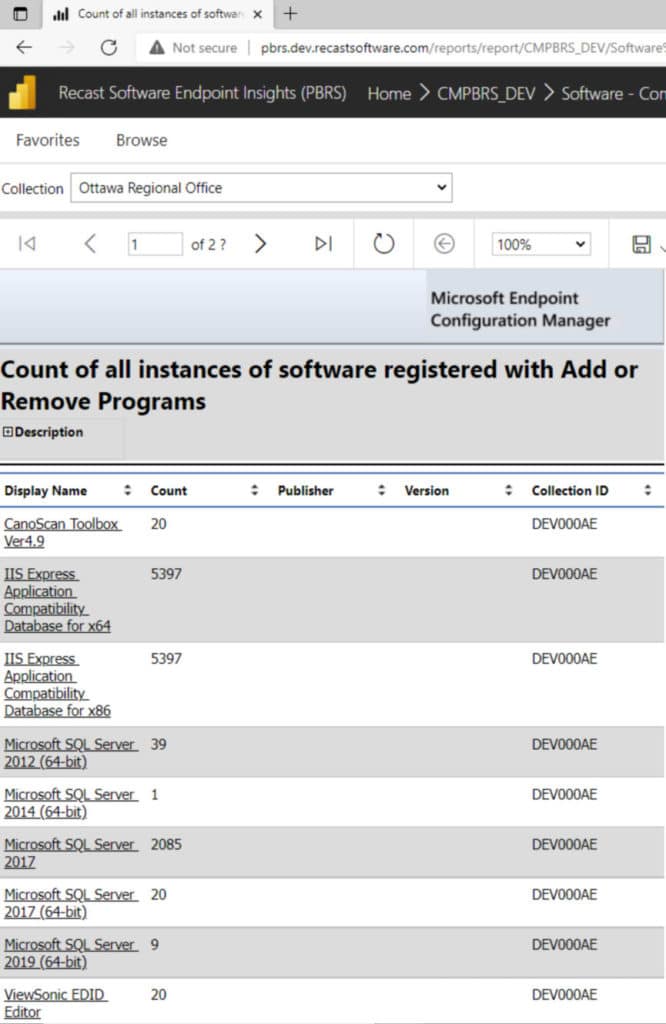
What’s Great about this Report?
- Reliability. When comparing all three of the main software inventory report types within ConfigMgr (Add/Remove Programs (ARP), Asset Intelligence (AI) and Software Inventory), this report provides the most reliable information.
- If you need to perform a software audit, then this is the report to look at! You should use this report whenever asked for a list of software within your environment.
4. Compliance 2 – Specific Software Update
Now that we’ve given you some of the best SCCM report examples, you can see that software and software update reports are among the best built-in ConfigMgr reports. Being able to SQL query the system for software updates lets you tackle bugs before they arise. This report, in particular, is very handy because you can use it to track the status of software updates (SUs). This requires, however, a bit of extra work on your part. First, you need to export this report at regular intervals and then examine the results over time.
One of the columns in this report that you should pay close attention to is called “Unknown.” The number in this column tells you how many computers haven’t returned details about the specified SU. When this number is above zero, it means that it’s time to investigate which clients are not reporting details. In an ideal world, the results for this column would always be zero.
Folder Location
It can be found within the Software Updates – A Compliance folder.
Microsoft Description
Displays the compliance data for a specified software update.
Compliance 2 – Specific Software Update Sample Screenshot
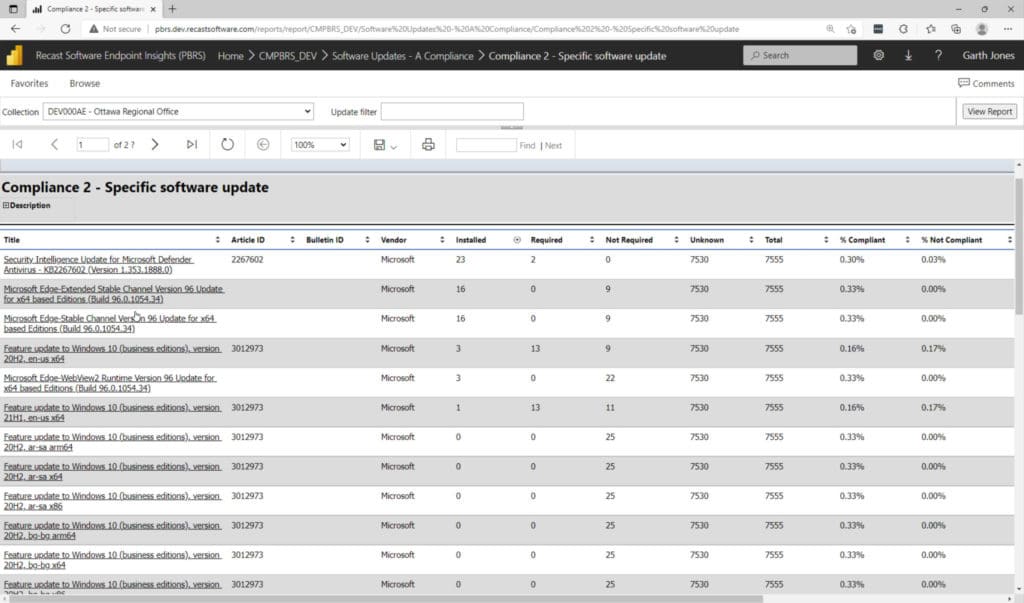
What’s Great about this Report?
- Without having to go out and purchase third-party reporting software or create SCCM custom reports, this built-in ConfigMgr report gives you a basic understanding about what’s happening with each SU within your environment.
- It provides a good, overall understanding of the specified SU’s compliance status.
5. Hardware 01A – Summary of Computers in a Specific Collection
If you need to find out basic details about computers within a specific collection, such as manufacturer, model, OS, etc., then this report is for you!
Folder Location
It is found within the Asset Intelligence folder.
Microsoft Description
Displays an Asset Intelligence summary view of computers in a collection you specify.
Hardware 01A – Summary of Computers in a Specific Collection Sample Screenshot
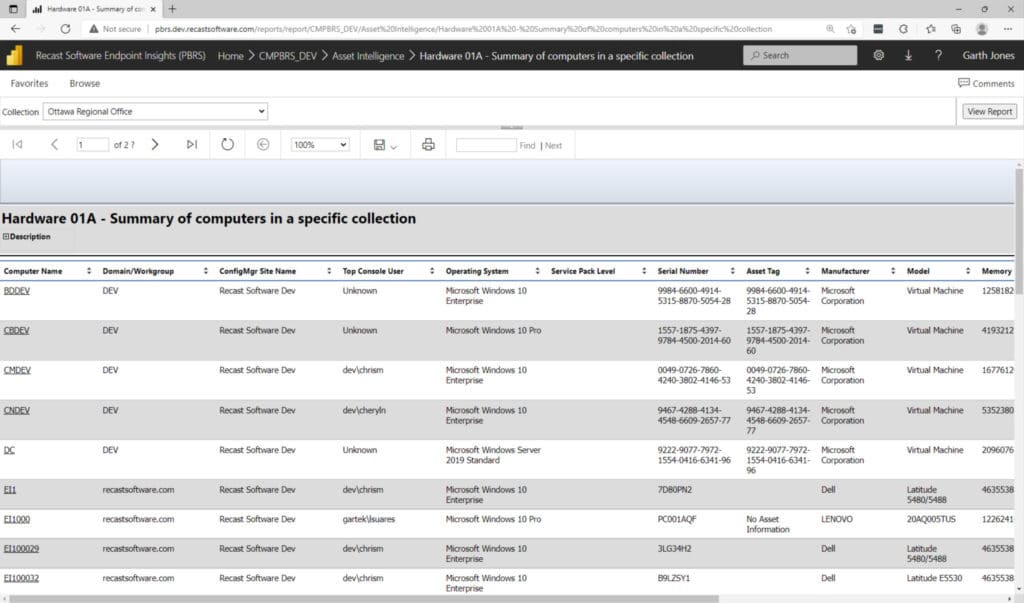
What’s Great About This Report?
- You can quickly see each computer’s details, such as CPU, RAM, user name, OS, and serial number.
- It is a simple one-stop-shop report which you can export to Excel if needed.
Five Best ConfigMgr Reports and Endpoint Insights
As you likely know by now, I’m the Senior Architect of Endpoint Insights for Recast Software, the leader in endpoint management software. At Recast Software, we are famous for our Right Click Tools which allow you to take actions on your computers. With Endpoint Insights, you can access critical endpoint data which is not natively available in ConfigMgr or other ITSMs.
You might be asking, “What is the connection between the five best ConfigMgr reports, Endpoint Insights, and Right Click Tools?” We recently added these ConfigMgr reports to the ConfigMgr console. Right Click Tools app lets you experience complete control over SCCM reporting tools, and now you can TAKE actions on your computers.
You can try this out by downloading the Community Edition of Right Click Tools. How this works:
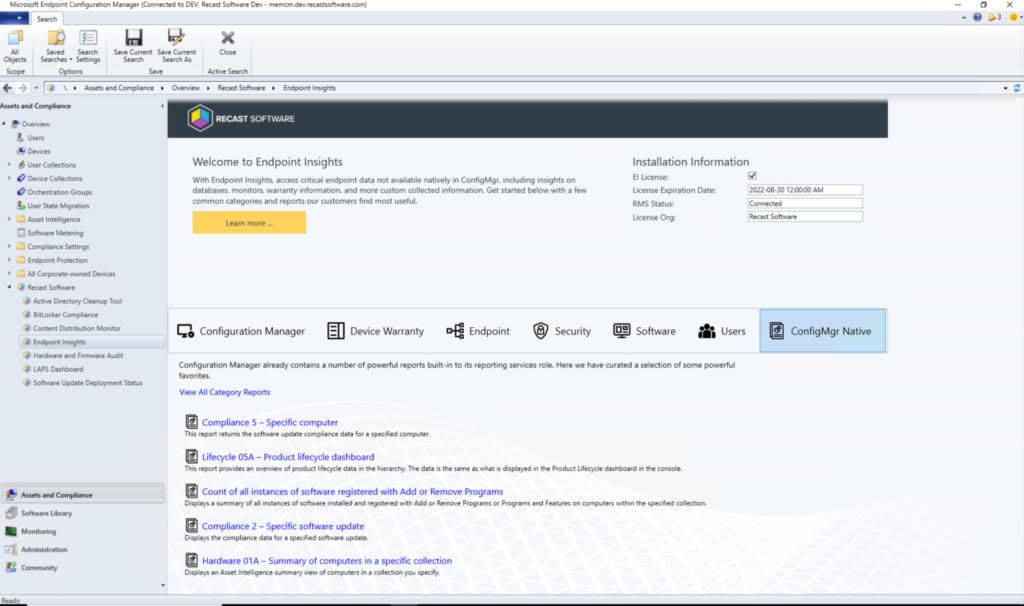
In the above screenshot, you can see the five best SCCM reports that I just reviewed. They are found within the Endpoint Insights console node on the ConfigMgr console.

When you run a report like Hardware 01A – Summary of computers in a specific collection, you can access the Right Click Tools (RCT) from a left click menu. As a community tool user, you will be able to access the community tools, and as an Enterprise customer, you can access all RCTs, even if you don’t have an Endpoint Insights license.
It might be hard to visualize what I’m talking about, so Marty Miller @ConfigMarty created a video showing what’s new in Right Click Tools 4.8. At the 3:40 mark, you can see where all the exciting action happens!
Endpoint Insights
Do you want to learn even more about what Endpoint Insights can do for you? Check out the Endpoint Insights product page.
Did I miss a built-in ConfigMgr report that you think should be here? Please let me know @GarthMJ. Also, I’d love to hear your suggestions for new reports, so let me know by creating an idea on our Ideas page. Make sure that you get everyone to vote for it!
The post The Five Best ConfigMgr Reports appeared first on Recast Software.
]]>The post Role-Based Administration (RBA) Reporting Feature in ConfigMgr / SCCM appeared first on Recast Software.
]]>Prior to the SCCM R2 release you were able to see all device (or user) collections regardless of your access to that resource or not. While this may not be an issue for many, for others it can be quite a headache if you have hundreds of device collections to scroll through to try to locate the ones actually accessible to you. This could also be a GDPR type issue for some multinational companies. Luckily, the release of CM12 R2 fixed that headache by allowing admins to view their collections only.
Example: With and Without RBA
In the following example you can see how things were before and after implementing RBA. This helps to illustrate just how RBA is leveraged to limit which collections a particular user can see based on their ConfigMgr security roles.
Permissions set for account accessing reports.
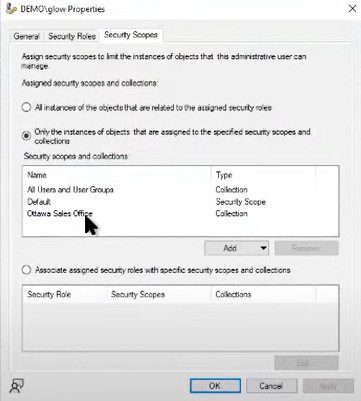
Before RBAC (note all collections are shown, even those we do not have permissions to).
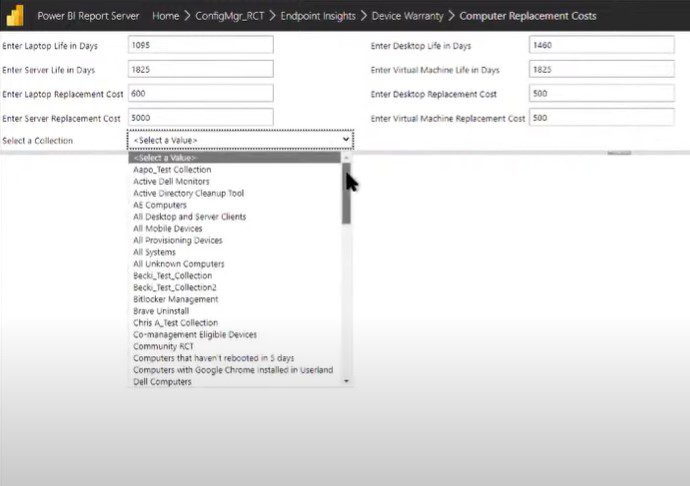
After RBAC (only the collections we have permissions to are listed).
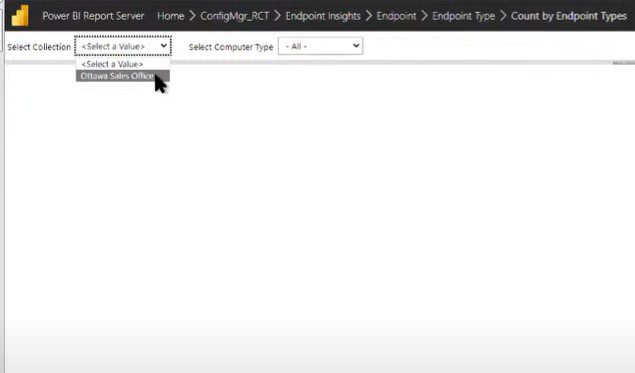
The RBA Standard
Do all reports, both community written or commercially available, follow the RBA standards? No, not all reports leverage RBA. Primarily, many authors don’t know how to write their reports to follow the standard. There is also a slight performance hit when leveraging RBA reports. However, this performance hit can be limited to a second or two when report queries are optimized. This means most people will never notice the time difference between an RBA and non-RBA report. But Software Update reports are the one place that you might see the difference in speed. As such, Endpoint Insight provides both RBA and non-RBA dashboards / reports. The team at Recast Software does follow the RBA standard for both console dashboards within Right Click Tool and both dashboard and reports within Endpoint Insights. We feel it is important to limit access to reports, if you as the MCM administrator have limited what other MCM Admins can see.
We also recently re-explored this topic in our Endpoint Insights Hidden Gems webinar. In this example, I showed you how Endpoint Insights is leveraging the MCM RBA to only display the collection that the user has access to.
I hope you found this information helpful. As always, if you have any questions, please feel free to reach out to me at @GarthMJ.
The post Role-Based Administration (RBA) Reporting Feature in ConfigMgr / SCCM appeared first on Recast Software.
]]>The post What is CMTrace and What is it Used For? The Ultimate Guide appeared first on Recast Software.
]]>What Makes CMTrace a Must-Have Tool?
There are numerous reasons to use this tool, but here are a few of my favorites:
-Log files can be reviewed in real time as they are updated, which can save you time.
-Multiple log files can be merged together to be viewed as one file.
-You can highlight text based on your own needs as you work through the logs. Don’t underestimate this feature.
-Ability to look-up error codes.
CMTrace Reads All MEMCM / SCCM Log Files
After working with MEMCM / SCCM for a while you will realize that there are almost 200 different Configuration Manager log files. To help you understand what each log file does, the MEMCM / SCCM documentation team listed and documented each one.
In order to open and view the complete list, here’s a link to the documentation. One of the things that you will notice on the update learning site, is that the logs are broken down by CM roles and functions. Making it easier for you to understand what logs to look at when troubleshooting an issue. This is particularly helpful when you are starting out with MEMCM / SCCM.
Given that CMTrace can read each log file, I strongly encourage you to give CMTrace a try!
Where Can I Find CMTrace?
MEMCM / SCCM
A while back the Microsoft Product team, included CMTrace as part of the CM client install. You no longer need to locate and install the Toolkit, just to find CMTrace. From a Run window type cmtrace and it should show up. If it doesn’t, you will find it under c:windowsccmcmtrace.exe.
For completeness, the toolkit tools still exist and are now included in the installation of MEMCM / SCCM. These tools, which include CMTrace, are updated as required with each cumulative update (CU).
The toolkit is found under the Tools folder. In my case the path to cmtrace.exe is:
E:Program FilesMicrosoft Configuration Managertools.
Don’t worry. When you first try to access the Tools folder, you will receive the following message: You don’t currently have permission to access this folder. Simply click on the Continue button, adjust the folder permissions and grant yourself access to the folder.
Usage notes about CMTrace:
A line highlighted in yellow generally indicates that there is a warning message, and a line highlighted in red generally indicates that there is an error message. BUT remember just because a line is highlighted in yellow or red doesn’t mean that it is a problem. You need to read the whole log file in context to determine if it is a problem.

For example, if you look at the purple arrow and noticed the red highlighted line, you will assume that the hardware inventory failed. But if you looked closely a few lines later you will see that the inventory was sent to your MP correctly. Context is important when reviewing the log files.
Error Message Lookup
In CMTrace, using the log snippet below as an example, I copied the 8004100E error code and open Error Lookup window using the Ctrl-L command. Then pasted the error code before click Lookup button. From there I can see what this error message means in plain text. Thereby pointing me in the right direction. In this case I already know that App-V is not installed and therefore the WMI namespace doesn’t exist, so this error is to be expected. Which makes it not really an error.

Highlight Lines
If you are troubleshooting something within the MEMCM / SCCM logs it can be useful to highlight the item in order to see it happen in real-time.
To do this within CMTrace, click on the Tools and Highlight… menu items.
In the Highlight text box enter the text that you want to highlight and then click on the OK button.
All instances of the text will be highlighted within the log file.
By default, the highlighted text will be shown in yellow. Since this can lead to some confusion because warning messages are also in yellow, I recommend changing the color to something different. See my next section on how to do that.
Without changing any of the colors, can you tell which one of the lines above has the highlighted text?
Pink Highlighted Lines

To change the default highlighted color, select the File and Preferences… menu items.
Click on the yellow box next to Use this color for highlighting log entries.
I find that using the color pink really stands out! However, you can use whatever you like, so choose a color and click OK.
Finally, click on the OK button. Now all of my highlighted text will be displayed in pink.
Now you can tell from the screenshot above what line has the highlighted text! In my opinion, you need to change the color of the highlighted text in order to quickly see it, and I think that the color pink is a great alternative.
To see these tips live, view my video demonstration!
Frequently Asked Questions (FAQs)
What are the system requirements for running CMTrace?
CMTrace is designed to be a lightweight and versatile tool, compatible with all recent versions of Windows that support Microsoft Configuration Manager (ConfigMgr). There are no specific system requirements beyond those needed for ConfigMgr itself. However, for optimal performance, it is recommended that your system aligns with the requirements of the ConfigMgr version you are using.
How does CMTrace compare to other log file viewers and management tools?
CMTrace stands out for its real-time log file monitoring capabilities, a feature not universally available in all log file viewers. Its ability to merge multiple log files for concurrent viewing and its unique text-highlighting functionality tailored to the user’s needs are particularly noteworthy. Compared to other tools, CMTrace is specifically optimized for ConfigMgr log files, providing a tailored experience that includes error code lookup and interpretation. While other tools might offer broader log management capabilities, CMTrace’s integration and specialized features for ConfigMgr environments make it a preferred choice for many IT professionals.
Can you offer guidance on advanced troubleshooting and error resolution with CMTrace?
Advanced troubleshooting with CMTrace involves a nuanced understanding of ConfigMgr log files and the common issues that may arise. The tool’s error lookup feature is invaluable for decoding error messages and pointing administrators in the right direction. When encountering an error, use CMTrace to highlight the error code and related messages to understand the context. Always consider the sequence of events leading to the error, as the root cause may be earlier in the log file than the error message itself. For complex issues, leveraging CMTrace’s ability to merge and simultaneously review related log files can provide a comprehensive view, aiding in the diagnosis of interconnected system behaviors. Remember, effective troubleshooting with CMTrace is as much about understanding the tool as it is about interpreting the logs in the context of your ConfigMgr environment.
The post What is CMTrace and What is it Used For? The Ultimate Guide appeared first on Recast Software.
]]>The post Better Together: Endpoint Insights and Right Click Tools Webinar Highlights appeared first on Recast Software.
]]>Attendance
- 112 people
- 8 IT Directors, 71 SysAdmins, 2 HelpDesk Analysts, 1 System Engineer, 28 Other
- 13 attendees already have Endpoint Insights and utilized the webinar to learn more
- 47 attendees joined to learn more about Endpoint Insights and its capabilities and synergies with Right Click Tools
- Attendees’ locations ranged from Estonia to Qatar, Redwood City to Pittsburgh.
Highlights
Endpoint Insights offers an All-In-One Computer View via right click, compiling data found outside of ConfigMgr. This view consolidates information on hardware (monitor, docking station, computer make/model, warranties), ConfigMgr health, drive information, software insights, and more. How is Right Click Tools and Endpoint Insights better together as a result? Users can take Right Click Tools actions within the All-In-One Endpoint Insights report, enabling actionable dashboards in Endpoint Insights as well as Right Click Tools.
Endpoint Insights brings profound visibility to all hardware. For instance, after identifying all docking stations, users can add them to a new docking station collection and run Right Click Tools on it. Users could run “Machine Policy Retrieval and Evaluation Cycle” to force the new docking station collection to pick up new updates recently deployed to the collection.
More broadly, all data unique to Endpoint Insights can be used to create novel collections not possible in ConfigMgr or Right Click Tools independently. Then Right Click Tools can be actioned on these collections.
Finally, Endpoint Insights scrubs data on user installed programs. Over 80% of webinar attendees polled shared security concerns over user-installed third-party software. Endpoint Insights surfaces this data, bringing light to potential vulnerabilities.
Question and Answer
Is there onboarding and training with Endpoint Insights?
Yes, Recast Software has a Customer Success team to onboard you. This team remains your champion and assistant for the duration of your relationship with Recast.
Can you display clients not part of a boundary group?
This feature is coming very soon.
What is your favorite Endpoint Insights report?
The All-In-One Computer Report gives a complete view of a device. We are constantly updating and adding more information to this report, too.
Does Right Click Tools integrate with Intune?
We work with Intune connected in co-managed environments.
How does Endpoint Insights update?
We send updates via the Recast Portal. Updates come out regularly that improve speed and add new information and features. Updates install the new set over the top.
Will Endpoint Insights cover off hardware TPM?
Yes, there is a complete report set on TPM in Endpoint Insights. We also have UEFI and Secure Boot status reports.
Better Together: Endpoint Insights and Right Click Tools
Right Click Tools embedded Recast Software into thousands of company’s endpoint management ecosystems. Right Click Tools empower SysAdmins to take advantage of the Systems Center Configuration Manager (SCCM) features more easily and completely. Endpoint Insights, a newer offering by Recast created by Garth Jones and his former company Enhansoft (acquired by Recast in February 2021), extends the SCCM capabilities to analyze environments more completely.
Learn more about Endpoint Insights and its ability to transform the work of your SysAdmin team.
The post Better Together: Endpoint Insights and Right Click Tools Webinar Highlights appeared first on Recast Software.
]]>









